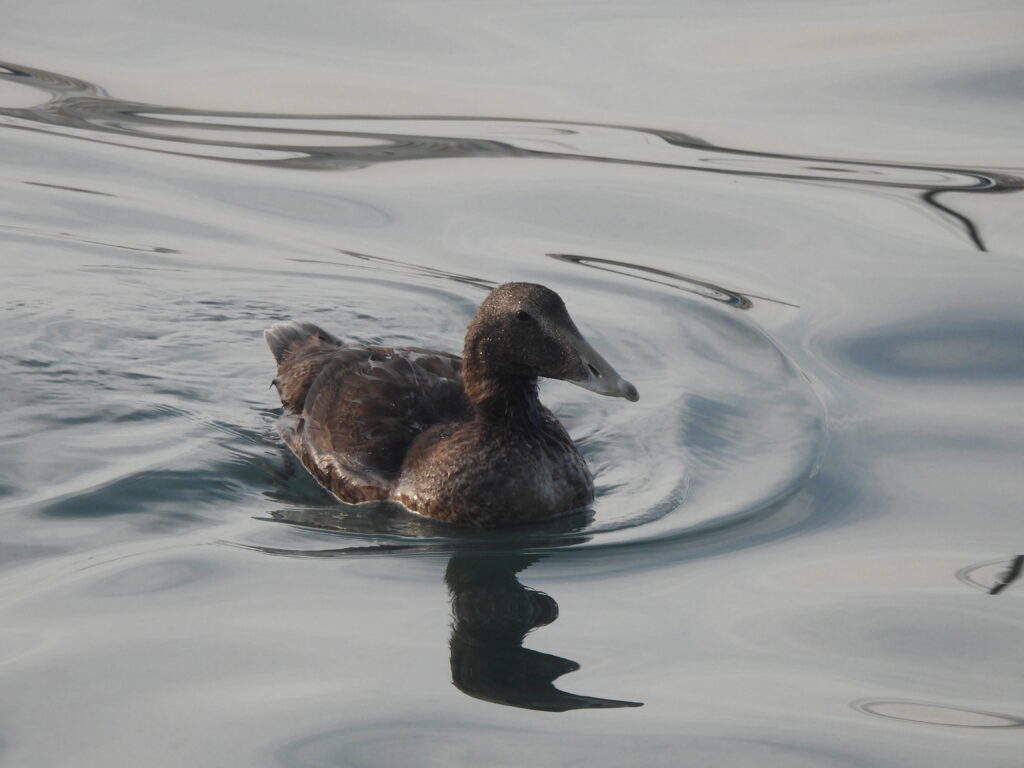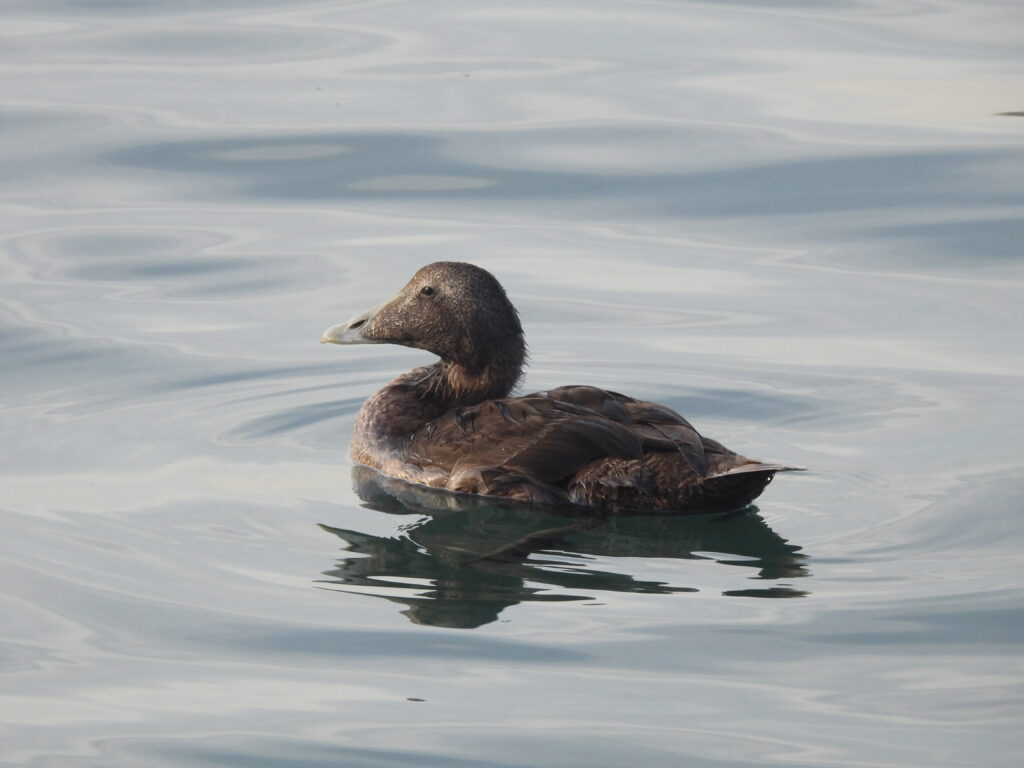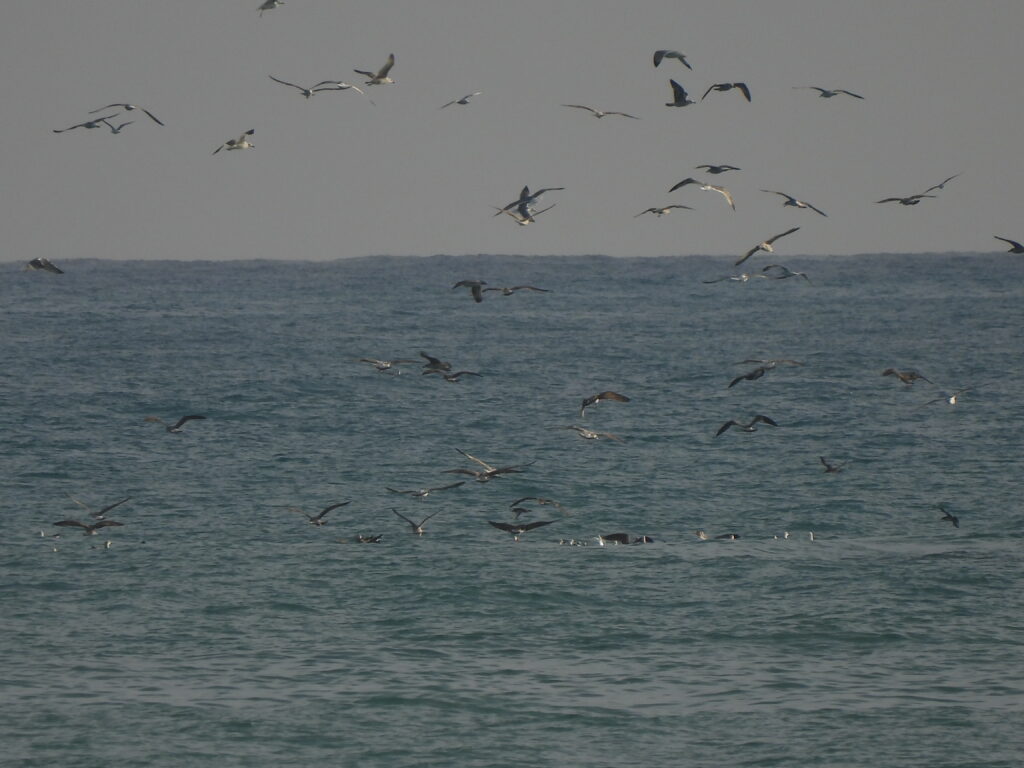Lately I’ve grown fond of the sea. Recently moving in Elx, a new place much more accessible to the beach than my hometown Alcoi often brings me chances to glimpse it on the horizon, or even directly go there. Last month my Indian friend Mihika Sen came all the way from Finland to visit and we drove around looking for birds, and the Mediterranean gave her several lifers — including my first gannet (Morus bassanus) of the season around Santa Pola.

30th Oct was a terrible day that will be remembered in the imaginary of all Valencians. An unusually extreme cold drop resulted in the deadliest storm of the Century in Spain and killed hundreds the day before. Among tens of dreadful videos of people suffering in floods, only one piece of news news felt slightly interesting.

Mario Marcos had found a common eider (Somateria mollissima) in Santa Pola and Jacobo Ramos found another one in Torrevieja. The storm might have forced these birds from up north in Vinaròs, Castelló, where they had been seen days before. My car was parked down in the street and I had just finished the work of the day.

I drove down to Santa Pola harbor some 20 minutes away from home and bumped into Marcos Real in his car as he left the area. It didn’t take long after I parked and got out of the car for me to spot a familiar silhouette of a big brown angular bird swimming in the middle of the pier. A juvenile eider swimming around

I remember I had looked for the common eider in Alicante on eBird to no avail, so I imagined these would be the very first records of the species in the platform. However, there had been previous records for Alicante. This species seems to undergo periodic influxes, with birds venturing southwards in them.

Indeed, two birds had been recorded in Vinaròs some weeks earlier, and the birds seem to match according to the pictures taken there, in Santa Pola and in Torrevieja. Weeks prior to that, two birds were recorded just some kilometers more north, in Delta de l’Ebre, where the species is relatively regular despite its rarity just past the border in the Valencian Community. All these records seem to be of these same two birds.

The newest edition of La Matruca (see here) provides four previous records of the species in south Alicante: a female in Nov 1993 in the beach in front of Salinas de Santa Pola, a female in Dec 1998 in Santa Pola, a young male in Nov 2007 again in Santa Pola, and two females at Desembocadura del Segura in Dec 2007. Besides, ornithological yearbooks provide a first-ever record of four birds in Oct 1988 in Calp — two of which staying for a month — and an injured female in Santa Pola in Nov 1999 collected and brought to the local rescue center.

On the one hand, this reminded me of the young male surf scoter (Melanitta perspicillata) that was first found by Sergio Arroyo in Torrevieja on 26th December and relocated in Desembocadura del Segura the following day, where it stayed until becoming a fine 2-cy male at least until 2 May this year! This long-staying bird was the 1st for the Valencian Community and the 2nd confirmed in the whole Mediterranean — as far as I know.

One would wish the eider would stick around too. Fishermen were regularly feeding it, as they also did in Vinaròs. The bird has then become pretty approachable (here I embed an awesome picture from Vinaròs from Guillem de los Santos). Unfortunately, this also meant that it had swallowed some fishing gear days later. In any case, no one has seen either of them after 12th Nov, so they might probably show up in some harbor again at some point during the winter.

On the other hand, the whole experience gave me a weird vibe. The very presence of these birds down here was a sign of everything that had happened and was still happening with the DANA (‘Depresión Aislada en Niveles Altos‘, as we call these storms) in Valencia. The sea and the sky were calm but the atmosphere somehow was not.

A look at the numerous fishing boats entering the pier at the end of the day provided great numbers of yellow-legged gulls (Larus michahellis), Audouin’s gulls (Ichthyaetus audouinii), slender-billed gulls (Chroicocephalus genei), Mediterranean gulls (Ichthyaetus melanocephalus), and some great cormorants (Phalacrocorax carbo), gannets and Mediterranean shearwaters (Puffinus yelkouan) of the ‘Balearic‘ mauretanicus form. Ruddy turnstones (Arenaria interpres), gray wagtails (Motacilla cinerea), European shag (Gulosus aristotelis), and lesser black-backed gulls (Larus fuscus) are usual suspects in Santa Pola in winter.

Birding has been quite diverse these days. Another duck made an appearance close to home, but this time in freshwater: a male blue-winged teal (Spatula discors) in Clot de Galvany on 11th Nov. Óscar Aldeguer found the bird early in the morning and several people tried to twitch it unsuccessfully. By the afternoon, I had spent some good time looking at the abundant waterfowl with Marcos, Borja Candela and Darío Gijón. At some point, Darío skillfully spotted the bird in the distance among shovelers (Spatula clypeata), and after enjoying it for a while we have not heard again of it. Another American mega vagrant without previous eBird records but with some actual records.

However, my mind was still at the sea. A second DANA was due to hit the affected areas some days later, but fortunately it ended up not as bad as predicted. However, winds became favorable. Darío and I spent the afternoon of 13th Nov at Cabo de las Huertas. The sea was extremely calm but hopes were high.

Cabo de las Huertas seems to be a better place for seabirds than Cabo de Santa Pola — apparently, the shallower waters and the presence of Tabarca island in front of the latest deter seabirds from getting between both pieces of land. Indeed, numerous balearic shearwaters and gannets can be seen.

The top bird of the session remained unfortunately unidentified. A 2-cy pale morph jaeger spotted flying up in the sky in the distance, heading southwards. The bird gave an impression of an overall large, stocky bird with a heavy flight. On the underside, the white belly patch was quite reduced, looking somewhat ‘dirty’. The underwing primaries area had a big extent of white, but we could not glimpse any ‘double comma’ pattern at such distance. On the upperwing, the white shaft area in the primaries was large, and the bird showed some white on secondary coverts.

Darío had been interested on jaegers for a while and has been studying their features, waiting for this moment to happen. Both of us have some experience with the three jaeger species with pale morph from our trip to Lapland last May. However, I failed to take any picture of the bird. While the bird was probably a pomarine jaeger (Stercorarius pomarinus), we prefer to play safe and keep it unidentified.

This fall has brought impressive birds from the Iberian Peninsula, including American and Siberian passerines of species and numbers that have never been recorded before. Besides the birds on the land, this winter seems quite promising to look out at the sea too.




